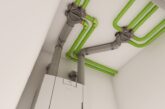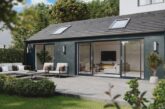
William Brown, MD of SuperFOIL Insulation, offers some top tips on making a self-build energy efficient.
When building an extension, or working on a renovation project, the ability to make a home energy efficient can be limited. However, when you’re involved in a self-build project, you’re in a position where every decision can contribute to the overall energy efficiency. From the very start of a project, energy efficiency can guide all your decisions, whether it’s the orientation of the home, the positioning of the walls, the choice of materials or the overall quality and finish.
Using windows for warmth
Few people understand the important role that windows play in warming and cooling a home. Lots of heat can be lost through windows so installing good quality windows can cut heating bills and make a house comfortable all year round. Many people believe that smaller windows mean a warmer home, but this isn’t always the case. The sun’s light can heat a home when it’s able to shine inside, so large windows which face the sun can maximise the amount of natural warmth entering the building. It’s true that heat can also be lost through windows but double or triple glazing can minimise this. There’s also much to be said for a good set of blinds or curtains to keep the heat in at night and prevent draughts. To prevent heat from being lost around the windows, you should also install high quality cavity closers to prevent the warmth from leaking out from the cavity.
![]()
Reject traditional insulation
Traditional insulation solutions use materials which sit between the rafters and studs of a property. However, there are more effective solutions which can not only improve energy efficiency, but also increase the interior space of the home. The traditional method requires the use of timbers which measure up to 225mm or more. This is far thicker than is required for structural strength and, since just 40mm of modern insulation can provide the same thermal resistance as 100mm of glass wool, there’s no reason to stick to tradition.
Alternatively, you could always double-up and use two layers of high performance insulation to make the home super-efficient. One type of insulation that self-builders may have heard of is multi foil which is made up of layers of foil, including a reflective layer, as well as wadding. It’s often used on new builds because it’s more energy efficient than many traditional types of insulation, it’s easy to install and is thinner than traditional insulation, making it suitable for walls, floors and ceilings. Moist insulation can become a big problem when it comes to the energy efficiency of a home. In the UK climate, it’s not unusual for rainwater to get inside the walls of a property and damage the insulation, causing it to lose its effectiveness. Multi foil, however, has a vapour control layer, preventing the insulation from becoming damp and keeping it effective, so is a much better choice when it comes to self-builds. Metal pipes and beams can also spoil a new home’s energy efficiency by becoming cold and radiating this into the house. You can eliminate this cold bridging by ensuring that metalwork is also wrapped up in insulation, just as the walls are. Rooftop energy saving The roof of a home offers some of the greatest opportunities to improve energy efficiency. Being the area most exposed to the sun, rooftop solar panels are a great way to produce low-cost renewable energy which can be used during the day, sold to the national grid, or stored using passive solar technology.
While battery storage for solar energy is still in its infancy and might not be a cost effective solution for many homes, solar energy can be efficiently stored as hot water, with power used to heat the water tank during the day. This, combined with efficient space heating and heat recovery ventilation systems, means that a home can be comfortable all year round using a fraction of the energy required for traditional systems. The roof is also one of the most important spaces for insulation. The Energy Saving Trust estimates that around 25 per cent of heat is lost through the roof of an uninsulated house, so good insulation here can dramatically improve the energy efficiency of a new home. Multi foil insulation is ideal for self-builders to use in the roofs of properties because it’s thinner and lighter than other types of insulation so is easy to handle, install, cut and seal.
Multi foil may be quite new, but it’s become a trusted solution for a wide range of projects. The use of multi foil insulation, along with other energy saving techniques, such as good quality windows and solar panels, is the ideal solution to making new and self-builds energy efficient, meaning they will be cooler in summer and warmer in winter, as well as saving the homeowner money.
![]()







